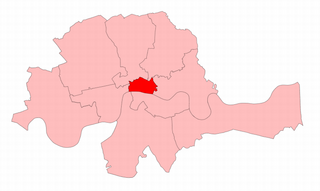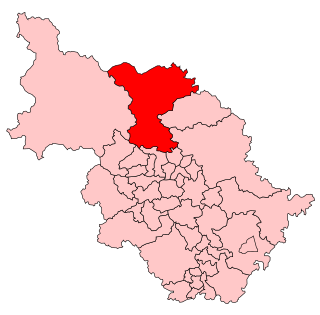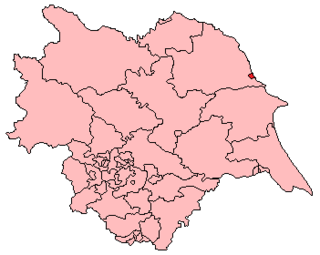Related Research Articles
Newtown was a parliamentary borough located in Newtown on the Isle of Wight, which was represented in the House of Commons of England until 1707, then in the House of Commons of Great Britain from 1707 to 1800, and finally in the House of Commons of the United Kingdom from 1801 to 1832. It was represented by two members of parliament (MPs), elected by the bloc vote system.
Ennis is a former United Kingdom Parliament constituency in Ireland, returning one MP. It was an original constituency represented in Parliament when the Union of Great Britain and Ireland took effect on 1 January 1801.

The City of London was a United Kingdom parliamentary constituency. It was a constituency of the House of Commons of the Parliament of England then of the Parliament of Great Britain from 1707 to 1800 and of the Parliament of the United Kingdom from 1801 to 1950.

Ripon was a constituency sending members to the House of Commons of England, Great Britain and the House of Commons of the Parliament of the United Kingdom until 1983, centred on the city of Ripon in North Yorkshire.

Scarborough was the name of a constituency in Yorkshire, electing Members of Parliament to the House of Commons, at two periods. From 1295 until 1918 it was a parliamentary borough consisting only of the town of Scarborough, electing two MPs until 1885 and one from 1885 until 1918. In 1974 the name was revived for a county constituency, covering a much wider area; this constituency was abolished in 1997.
Malton, also called New Malton, was a constituency of the House of Commons of the Parliament of England in 1295 and 1298, and again from 1640, then of the Parliament of Great Britain from 1707 to 1800 and of the Parliament of the United Kingdom from 1801 to 1885. It was represented by two Members of Parliament until 1868, among them the political philosopher Edmund Burke, and by one member from 1868 to 1885.

West Riding of Yorkshire was a parliamentary constituency in England from 1832 to 1865. It returned two Members of Parliament (MPs) to the House of Commons of the Parliament of the United Kingdom.
Pontefract was an English parliamentary constituency centred on the town of Pontefract in the West Riding of Yorkshire, which returned two Members of Parliament to the House of Commons briefly in the 13th century and again from 1621 until 1885, and one member from 1885 to 1974.
Rutland was a parliamentary constituency covering the county of Rutland. It was represented in the House of Commons of the Parliament of the United Kingdom until 1918, when it became part of the Rutland and Stamford constituency, along with Stamford in Lincolnshire. Since 1983, Rutland has formed part of the Rutland and Melton constituency along with Melton Mowbray from Leicestershire.
Boroughbridge was a parliamentary borough in Yorkshire from 1553 until 1832, when it was abolished under the Great Reform Act. Throughout its existence it was represented by two Members of Parliament in the House of Commons.
Northallerton was a parliamentary borough in the North Riding of Yorkshire, represented by two Members of Parliament in the House of Commons briefly in the 13th century and again from 1640 to 1832, and by one member from 1832 until 1885.
Knaresborough was a parliamentary constituency which returned two Members of Parliament (MPs) to the Parliament of England, Parliament of Great Britain and the House of Commons of the Parliament of the United Kingdom until 1868, and then one MP until its abolition in 1885.

East Cumberland is a former county constituency in the House of Commons of the Parliament of the United Kingdom. It elected two Members of Parliament (MPs) by the bloc vote system of election.
Cockermouth was the name of a constituency of the House of Commons of the Parliament of England in 1295, and again from 1641, then of the Parliament of Great Britain from 1707 to 1800 and of the Parliament of the United Kingdom from 1801 to 1918. It was a parliamentary borough represented by two Members of Parliament until 1868, and by one member from 1868 to 1885. The name was then transferred to a county constituency electing one MP from 1885 until 1918.
Midhurst was a parliamentary borough in Sussex, which elected two Members of Parliament (MPs) to the House of Commons from 1311 until 1832, and then one member from 1832 until 1885, when the constituency was abolished. Before the Great Reform Act of 1832, it was one of the most notorious of England's rotten boroughs.
Portsmouth was a borough constituency based upon the borough of Portsmouth in Hampshire. It returned two members of parliament (MPs) to the Parliaments of England, Great Britain and from 1801 the House of Commons of the Parliament of the United Kingdom, elected by the bloc vote system.
Bletchingley was a parliamentary borough in Surrey. It returned two Members of Parliament (MPs) to the House of Commons of England from 1295 to 1707, to the House of Commons of Great Britain from 1707 to 1800, and to the House of Commons of the United Kingdom until 1832, when the constituency was abolished by the Great Reform Act.
Wilton was the name of a parliamentary borough in Wiltshire. It was represented in the House of Commons of the Parliament of England from 1295 to 1707, then in the Parliament of Great Britain from 1707 to 1800 and finally in the House of Commons of the United Kingdom of the Parliament of the United Kingdom from 1801 to 1918. It had two Members of Parliament (MPs) until 1832, but from 1832 to 1885 only one member, as a result of the Reform Act 1832 where it also absorbed the former rotten borough of Old Sarum. In 1885 the borough was abolished, but the name of the constituency was then transferred to a new county constituency electing one Member from 1885 until 1918.
Liskeard was a parliamentary borough in Cornwall, which elected two Members of Parliament (MPs) to the House of Commons from 1295 until 1832, and then one member from 1832 until 1885. The constituency was abolished by the Redistribution of Seats Act 1885.
Castle Rising was a parliamentary borough in Norfolk, which elected two Members of Parliament (MPs) to the House of Commons from 1558 until 1832, when it was abolished by the Great Reform Act. Its famous members of Parliament included the future Prime Minister Robert Walpole and the diarist Samuel Pepys.
References
- D. Brunton & D. H. Pennington, Members of the Long Parliament (London: George Allen & Unwin, 1954)
- "Cobbett's Parliamentary history of England, from the Norman Conquest in 1066 to the year 1803" (London: Thomas Hansard, 1808)
- F W S Craig, "British Parliamentary Election Results 1832-1885" (2nd edition, Aldershot: Parliamentary Research Services, 1989)
- J Holladay Philbin, "Parliamentary Representation 1832 - England and Wales" (New Haven: Yale University Press, 1965)
- Henry Stooks Smith, "The Parliaments of England from 1715 to 1847" (2nd edition, edited by FWS Craig - Chichester: Parliamentary Reference Publications, 1973)
- Frederic A Youngs, jr, "Guide to the Local Administrative Units of England, Vol II" (London: Royal Historical Society, 1991)
- Leigh Rayment's Historical List of MPs – Constituencies beginning with "T" (part 1)